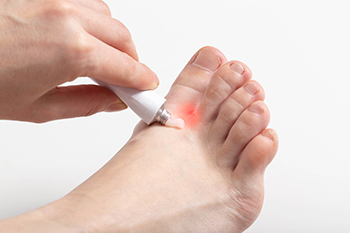
Athlete's foot is a common foot infection caused by a fungus that may enter the skin through cuts, cracks, or sores. Athlete's foot spreads through contact with infected people, sharing towels, or walking barefoot in communal spaces, like shower stalls or public locker rooms. Individuals with poor foot hygiene, such as infrequent washing or changing socks, face an elevated risk of developing athlete’s foot. Symptoms include cracks or blisters, redness, swelling, and itching on the feet's bottoms or sides. Additional symptoms are a burning sensation, scaly or peeling skin, bad odor, and abnormal toenails. Diagnosis involves visual examination by a chiropodist or analysis of a skin sample under a microscope to identify the specific fungus. Treatment typically consists of antifungal medicines in cream or pill form, with the importance of completing the prescribed medication even if symptoms improve. Early detection of athlete’s foot symptoms and proper care of the infected feet are paramount, as the infection is extremely contagious. If you believe you have athlete’s foot, it is suggested that you schedule an appointment with a chiropodist as quickly as possible for an exam and treatment.
Athlete’s foot can be uncomfortable and unsightly. To learn more about preventing and treating this condition, please consult with one of the chiropodists from Complete Family Footcare & Therapy. Our clinicians will assess your condition and provide you with quality foot and ankle treatment.
What Is Athlete’s Foot?
Athlete’s foot refers to an infection of the skin on the feet that is caused by a fungus. This fungus is contagious and thrives in warm and moist environments. It is often spread in common areas such as public pools, locker rooms, and showers. It can also spread when sharing personal items, like shoes or towels, with an infected person.
Symptoms
The symptoms of athlete’s foot may include:
Itching, stinging, or burning of the skin on the feet
Cracking or peeling skin, especially between the toes and on the soles of the feet
Scaly, red rash on the foot
Blisters
Foul odor
Treatment
Treatment for athlete’s foot typically involves using over-the-counter topical antifungal medications on the feet. When over-the-counter options are ineffective, you may need to take prescription oral medications or topical antifungal drugs, or a combination of both.
Prevention
Preventing athlete’s foot places an emphasis on good foot hygiene practices.
You can prevent athlete’s foot by:
Washing and drying your feet thoroughly every day
Wearing shoes when walking in public areas
Not sharing personal items, like shoes or socks, with others
Wearing shoes and socks made out of breathable materials
If you have any questions, please feel free to contact our offices located in . We offer the newest diagnostic and treatment technologies for all your foot care needs.
